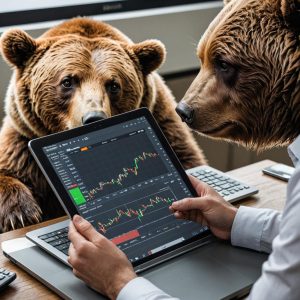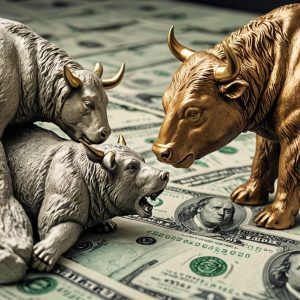Bearish or Bullish?
Up, Down or Sideway?
The trend is not your friend, because it can end.
Three kinds of trends can be seen in the timeframes.
(1) Trend Following
PRIMARY TREND
— Uptrend (Bullish)
— Downtrend (Bearish)
SECONDARY TREND
— Correction
— Flat (Non-trading)
— Ranging (Unstable)
— Bear Market Rally
(2) Overbough / Oversold
(Top and Bottom)
(3) Breakout
Market Trends
By understanding market trends and their movements, investors can make the right decision in right time to maximize their gain and minimize their losses.
When it comes to the stock market, one of the most talked about trends is bullish and bearish trends. Typically, a bull market is characterised by continual rising prices and marked by investor optimism. A bearish trend, on the other hand, is characterized by a downward trend in prices and is marked by pessimism among investors.
In Forex trading, the terms ‘bullish’ and ‘bearish’ are commonly used to describe price movements. When an investor is bullish on an underlying asset, it means that he believes that its price will rise in the future. On the flip side, when an investor is bearish on an underlying asset, it means that he believes that its price will decrease soon or later.
Bearish Concept
The concept of bearish in trading forex is a simple, yet powerful tool in the forex market. This strategy revolves around the idea of shorting a specific currency when the conditions are right, in order to make a profit when the value of the currency decreases.
Typically, traders want to enter a bearish position in a currency pair when they expect the pair to weaken due to economic or political events or when there is a heightened risk of a currency failing. This could include a decrease in the value of the U.S. dollar due to inflation, for example.
Affect Factors
Forex go up and down due to many reasons. There are several factors that affect currency prices. Main reason is supply and demand, buying and selling of forex. Next are volatility and period. More buyers or more sellers creates especially wars or other conflicts, concerns over inflation or deflation, government fiscal and monetary policy, technological changes, natural disasters or extreme weather fluctuations and corporate or government performance data.
Forex goes through periodic ups and downs continueously and regularly for no particular reason at certain times, such as 10 o’clock, 3:30 p.m., and 5 p.m., almost every day. Please refer to the economic calendar for more information.
Dollar Index
US Dollar Index (DXY, DX, USDX) measures the value of the US Dollar against other foreign currencies. DXY goes up when the US dollar gains strength value when compare to other currencies, and opposite, nowadays on range of one hundred -10/+10.
The DXY is widely watched by investors, policymakers, and analysts. There are several factors that can influence the movements of the DXY. One of the most significant is the monetary policy decisions of the Federal Reserve, the central bank of the United States. When the Fed raises interest rates, it tends to attract foreign investments and increase demand for the dollar, which can lead to a higher DXY, – and conversely.
Read more …
Cryptocurrencies
Bitcoin is increasing popularity fast recently. It is one of potentially profitable asset right now. Cryptocurrencies (Bitcoin BTC, Litecoin LTC, Ethereum ETH, Zcash ZEC, Dash, Ripple XRP, Monero XMR) are classified as a subset of digital, alternative and virtual currencies. Cryptocurrency market volatility is quite high, so you can make a quick payout. BTC can be traded 24/7.
Commidities
Commodities are physical goods that can be bought and sold. Commodities refer to specific types of goods that have value and are traded on markets.
Some common examples of commodities include precious metals, such as gold and silver, agricultural products like wheat and soybeans, and energy resources such as oil and gas.
Commodity prices are often subject to supply and demand conditions in international markets and can be influenced by geopolitical events and weather events.
If the global economy is showing positive signs, this reflecte in rising commodity prices, especially gold and oil. Investors are optimistic about the global economy, which supports the upward trend. With central banks around the globe keeping interest rates low, monetary policies favor the this trend.
Gold Trading
Gold has been used as a form of currency and a store of value for thousands of years, and its value has remained relatively stable over time. Today, gold trading is a popular form of investment, with individuals and institutions around the world buying and selling gold for profit.
Gold has long been considered a safe-haven investment in the trading market because of its ability to hold its value during times of economic uncertainty. This precious metal has been used for centuries as a currency and store of value, and its scarcity and durability have made it a reliable choice for many investors looking to hedge against market volatility.
One reason gold is considered a safe-haven asset is its limited supply. Unlike paper currencies, which can be printed and devalued at will, gold is a finite resource that cannot be easily replicated. This scarcity reduces the risk of inflation and makes gold a more stable investment option.
Moreover, gold has a proven track record of retaining its value over time. Throughout history, gold has been used as a currency and store of value by numerous civilizations. This longevity attests to its durability, which makes it a favorable investment option for those looking to protect their wealth in the long term. Additionally, gold is immune to the fluctuations of other financial assets.
Oil Trading
Oil trading is a highly important aspect of the global economy. It involves the buying and selling of crude oil and refined products such as gasoline, diesel, and jet fuel.
The world heavily depends on oil for transportation, heating, and electricity, making it one of the most valuable commodities for both individuals and industries alike.
Oil trading typically takes place in the commodity market, where crude oil and refined products are traded to meet the demands of consumers. The price of oil is determined by supply and demand factors, as well as geopolitical issues, natural disasters, and regulatory changes.
The fluctuations in oil prices can have a significant impact on the economies of countries, industries, and individuals.
The players in the oil trading market include producers, traders, and consumers. Oil-producing countries such as Saudi Arabia, Russia, and the United States are major players in the market, as they possess the largest reserves of crude oil. Traders, on the other hand, are individuals or companies who buy and sell oil for profit.
GOLD: Xau/Usd
OIL: Crude Oil
Currency Rates
Heat Map











